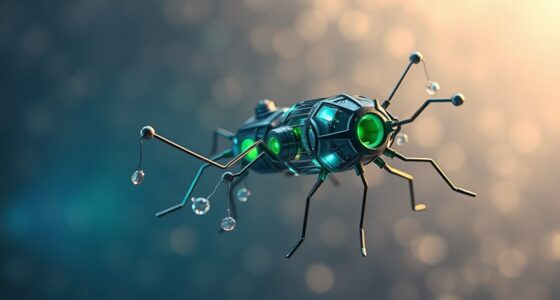Nanomachines in agriculture are revolutionizing how you deliver fertilizers and pesticides. They target pests and nutrients precisely, reducing waste and environmental impact. Smart fertilizers use nano-encapsulation and controlled release to provide nutrients when plants need them, while nanotechnology allows for targeted pest control, minimizing chemical runoff. These innovations improve crop efficiency and support sustainable farming. If you keep exploring, you’ll discover even more about how these tiny devices are shaping the future of farming.
Key Takeaways
- Nanomachines enable precise, targeted delivery of fertilizers and pesticides, reducing environmental waste and increasing crop efficiency.
- Nano-encapsulation protects nutrients and chemicals, releasing them in response to soil conditions or plant signals.
- Smart nanocarriers and responsive nanodevices ensure controlled, on-demand release of agrochemicals, minimizing runoff.
- Nanotechnologies improve soil health, water retention, and crop resilience while reducing chemical usage and pollution.
- Future developments include autonomous nanobots for real-time monitoring and precision farming with enhanced sustainability.
The Role of Nanomachines in Modern Farming
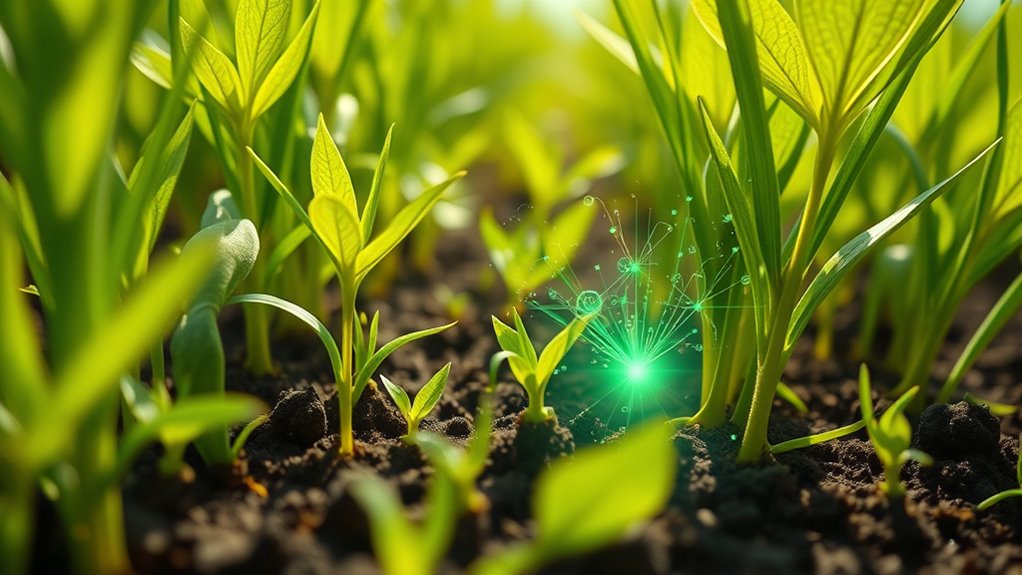
Have you ever wondered how cutting-edge technology is transforming agriculture? Nanomachines are at the forefront of this revolution. They’re tiny devices, often just a few nanometers in size, designed to perform specific tasks with precision. In modern farming, nanomachines can target pests, deliver nutrients, and monitor crop health in real-time. Unlike traditional methods, they work efficiently, reducing waste and environmental impact. By integrating into soil and plants, nanomachines enable farmers to optimize resource use, improve yields, and cut costs. Their ability to operate at a microscopic level makes them incredibly versatile, opening new possibilities for sustainable agriculture. As they become more advanced, nanomachines are set to reshape how we grow food, making farming smarter, cleaner, and more productive. Self Watering Plant Pots exemplify how integrating technology into agriculture can promote efficient resource management.
How Smart Fertilizers Work at the Nano Level
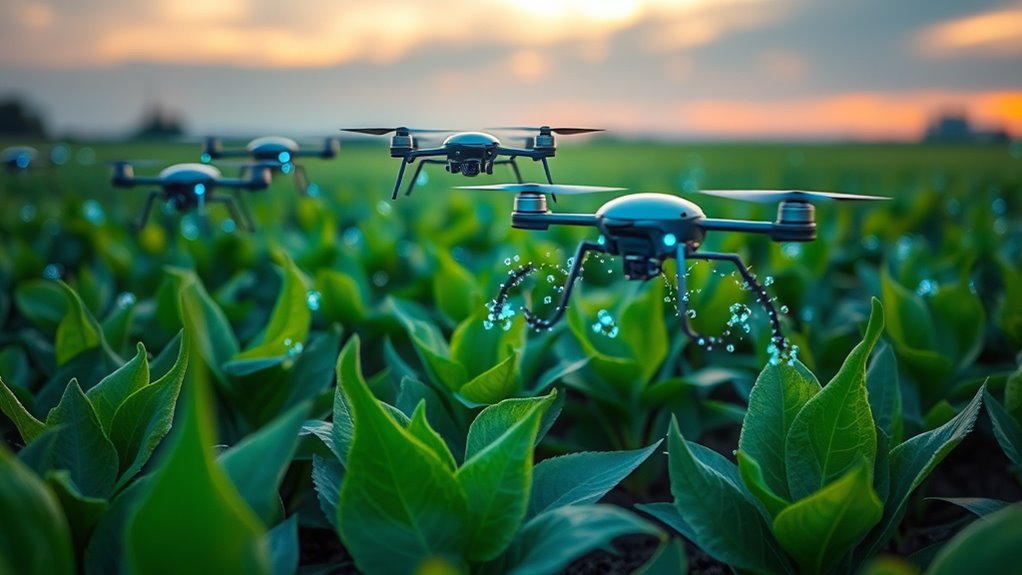
Smart fertilizers use nano-encapsulation to protect nutrients until they’re needed, ensuring they stay available longer. They also feature controlled release mechanisms that deliver nutrients gradually, matching plant needs. Additionally, these fertilizers interact precisely with soil, targeting roots directly for maximum efficiency. Incorporating these advanced technologies can reduce nutrient wastage and improve crop yields significantly.
Nano-Encapsulation of Nutrients
Nano-encapsulation of nutrients involves enclosing essential fertilizers within tiny particles that can precisely deliver nutrients to plants. These nano-sized carriers protect nutrients from environmental losses like leaching and volatilization, ensuring more efficient use. When applied, the encapsulated nutrients stay stable, preventing premature release. The nano-capsules can be engineered to adhere to plant surfaces or soil particles, increasing contact and absorption. This targeted approach minimizes waste and reduces the need for excessive fertilizer application, lowering environmental impact. By controlling the release of nutrients, nano-encapsulation enhances uptake during key growth stages, promoting healthier plants and higher yields. Additionally, the choice of materials for nano-encapsulation can be tailored for material durability, ensuring longevity and effectiveness throughout the growing season. Overall, this technology maximizes fertilizer efficiency, conserves resources, and supports sustainable agriculture practices.
Controlled Release Mechanisms
Nano-encapsulation lays the groundwork for controlled release by protecting nutrients until they are needed, but sophisticated mechanisms further refine this process. These mechanisms respond to environmental cues like moisture, pH, or plant signals to release nutrients precisely when your crops need them. Imagine tiny gates opening only under specific conditions, ensuring minimal waste and maximum efficiency. To visualize, consider this table:
| Trigger | Mechanism | Effect |
|---|---|---|
| Moisture detect | Hydrogels swell, releasing nutrients | Water activates release |
| pH change | pH-sensitive coatings dissolve | Soil acidity adjusts release |
| Plant signals | Enzymatic triggers unseal nutrients | Root presence signals release |
These smart systems work in harmony, delivering nutrients exactly when the plant demands, optimizing growth and reducing environmental impact. Controlled release mechanisms are further enhanced by advances in nanotechnology, enabling even more precise nutrient delivery.
Targeted Soil Interaction
By leveraging nanotechnology, fertilizers can interact directly with specific soil components to deliver nutrients precisely where they’re needed. Nanoparticles are engineered to recognize certain soil molecules or pH levels, ensuring they release nutrients only in targeted zones. For example, they can bind to clay particles or organic matter, anchoring nutrients close to plant roots. This targeted approach minimizes nutrient runoff and environmental waste. Additionally, surface modifications on nanoparticles enable them to respond to soil stimuli, such as moisture or temperature changes, triggering nutrient release at ideal times. By focusing on soil chemistry at the nano level, smart fertilizers maximize efficiency, reduce excess usage, and support sustainable farming practices. This precise interaction transforms traditional fertilization into an intelligent, environmentally friendly process. Incorporating soil interaction techniques at the nano scale further enhances nutrient delivery accuracy and effectiveness.
Precision Pest Control With Nanotechnology
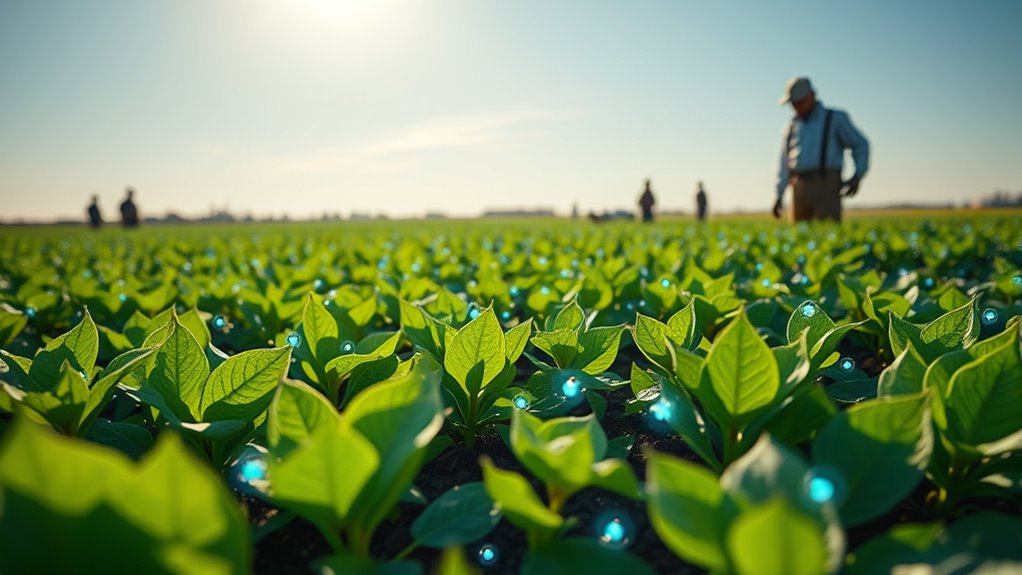
Advances in nanotechnology are revolutionizing pest control by allowing for highly targeted and efficient methods. You can now deploy nanoscale pesticides that specifically identify pest species, minimizing impact on beneficial insects and the environment. These nanomaterials can penetrate pest exoskeletons or tissues, delivering lethal doses directly where needed. Nanocarriers enable controlled release, ensuring pesticides activate only when pests are present, reducing excess chemical use. This precision minimizes chemical runoff and soil contamination, making pest management safer and more sustainable. Additionally, nanosensors can detect pest presence early, prompting targeted interventions before infestations escalate. Water parks in various locations demonstrate how innovative designs and technology enhance user experience while prioritizing safety and environmental considerations. As a result, you gain a more effective, eco-friendly approach to pest control that saves resources and protects your crops from harm.
Environmental Benefits of Nano-Enabled Agriculture

Nano-enabled agriculture can profoundly reduce chemical runoff, helping protect nearby water sources. It also promotes healthier soils by improving nutrient delivery and minimizing pollution. These advancements make farming more sustainable and environmentally friendly. Additionally, the use of personalized compatibility insights based on zodiac signs and cultural zodiac systems can optimize crop management strategies for different regions.
Reduced Chemical Runoff
Reduced chemical runoff is one of the key environmental benefits of nanomachines in agriculture. These tiny devices deliver fertilizers and pesticides precisely where needed, minimizing excess application. Because nanomachines target specific plants or pests, less chemical waste escapes into surrounding soil and water. This precision reduces contamination of rivers, lakes, and groundwater, helping protect aquatic ecosystems and drinking water sources. Additionally, with less runoff, you decrease the risk of harming non-target species and reduce the development of resistant pests. Overall, nanomachines enable you to use chemicals more efficiently, lowering environmental impact while maintaining crop productivity. This smarter delivery system supports sustainable farming practices and promotes healthier ecosystems. It’s a significant step toward reducing pollution and preserving natural resources.
Enhanced Soil Health
By improving how nutrients are delivered to the soil, nanomachines help maintain its health and structure. They guarantee nutrients are released slowly and precisely where plants need them, preventing over-fertilization that can degrade soil quality. This targeted approach promotes microbial activity and enhances soil biodiversity, both essential for nutrient cycling and plant growth. Additionally, nanomachines can break down pollutants and contaminants, reducing soil toxicity. This cleaner environment encourages healthy root development and improves water retention. As a result, soil becomes more resilient and productive over time. By minimizing chemical buildup and promoting natural processes, nano-enabled agriculture supports sustainable practices. You’ll see healthier soils that retain nutrients longer, reduce erosion, and foster a balanced ecosystem, ultimately leading to more resilient and fertile land. Incorporating farmhouse-inspired design principles can further enhance sustainable land management practices.
Challenges and Risks of Using Nanomachines in Fields

While nanomachines hold great promise for transforming agriculture, their deployment also presents significant challenges and risks. You might worry about unintended environmental impacts, like nanomachines accumulating in soil and water, potentially harming ecosystems. There’s also the concern of controlling and containing these tiny devices once released, which could lead to unforeseen spread beyond targeted areas. Safety for farm workers and consumers is another issue, as long-term health effects of nanomaterials remain uncertain. Additionally, ethical questions arise around data privacy and the potential for misuse. Developing regulations and standards takes time, and without proper oversight, risks of misuse or accidents increase. Balancing innovation with caution is essential to guarantee nanomachines enhance farming without causing harm. According to glycolic acid products, proper safety protocols and research are crucial for integrating new technologies responsibly.
Innovations in Delivery Systems for Crops

Innovations in delivery systems for crops are revolutionizing how nutrients and pesticides reach plants, making applications more efficient and targeted. Nanotechnology enables precise delivery directly to plant roots or leaves, reducing waste and environmental impact. Nanomachines can release chemicals in response to specific triggers, ensuring optimal timing and dose. These advancements improve crop yields and decrease chemical runoff. To illustrate, consider the following delivery methods:
| Method | Advantage | Application example |
|---|---|---|
| Nano-encapsulation | Protects active ingredients | Controlled pesticide release |
| Smart nanocarriers | Targeted delivery | Nutrients to root zones |
| Responsive nanodevices | Triggered release by environment | Pesticides released upon pest detection |
| Biodegradable nanoparticles | Eco-friendly breakdown | Fertilizer delivery |
| Microneedle patches | Direct leaf application | Quick pesticide absorption |
Furthermore, understanding the regulatory landscape for nanotechnology in agriculture is crucial for safe and compliant implementation.
Case Studies: Successful Applications of Nanotech in Agriculture

Numerous successful applications of nanotechnology in agriculture showcase its potential to transform farming practices. For example, nano-enhanced fertilizers release nutrients gradually, boosting crop yields while reducing waste. In one case, farmers used nano-based pesticides that targeted pests precisely, minimizing environmental impact and decreasing chemical usage. Researchers also developed nanosensors that monitor soil health, allowing you to optimize irrigation and fertilization in real-time. These innovations have led to increased efficiency and sustainability in various crops worldwide. Additionally, nano-coatings on seeds improve germination rates and protect against diseases. Such case studies prove that nanotech isn’t just theoretical; it delivers tangible benefits, helping you grow healthier crops with fewer inputs and a lower ecological footprint. These successes mark a significant step toward smarter, more sustainable agriculture.
Future Perspectives on Nano-Driven Farming Solutions

As nanotechnology continues to advance, its potential to revolutionize farming becomes increasingly evident. In the future, you’ll see smarter, more efficient agricultural practices driven by nanomachines. These innovations could lead to precise nutrient delivery, reduced chemical use, and enhanced crop resilience. You might also benefit from autonomous nano-robots that monitor soil health in real-time, optimizing inputs for better yields. Here’s a glance at upcoming trends:
| Technology | Impact |
|---|---|
| Smart nano-sensors | Real-time soil and crop monitoring |
| Targeted nano-delivery | Reduced chemical runoff and environmental harm |
| Autonomous nanobots | Precision farming with minimal human intervention |
Regulatory and Ethical Considerations in Agricultural Nanotechnology
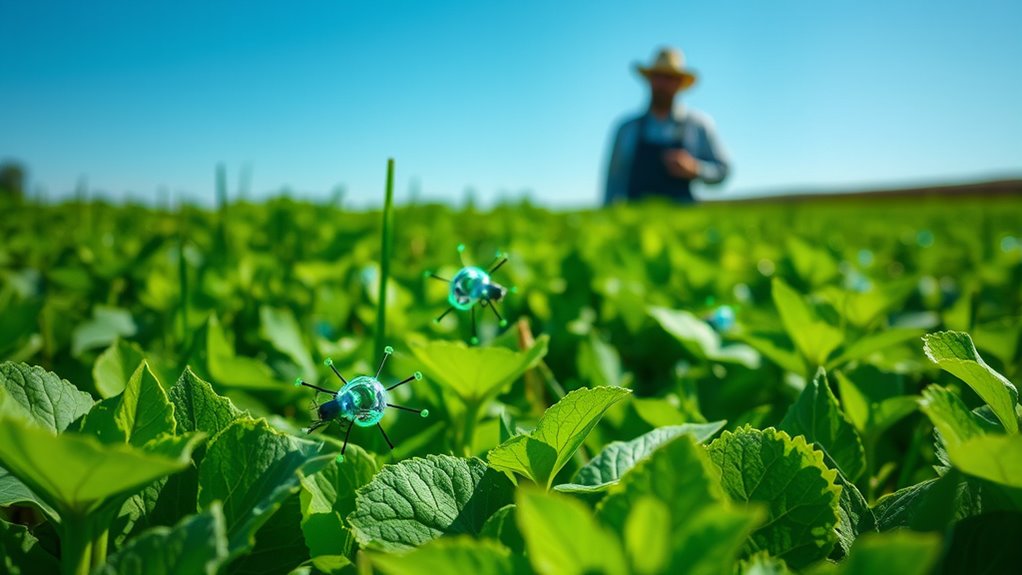
While the promise of nanotechnology in agriculture is exciting, it also raises significant regulatory and ethical questions. You need to contemplate how these tiny machines might impact human health and the environment. Regulations are still evolving, and you must stay informed about safety standards and approval processes. Ethical concerns include potential risks to ecosystems, biodiversity, and long-term sustainability. Transparency is vital; you should guarantee that farmers and consumers understand how nanomaterials are used and their effects. Additionally, equitable access to nanotech solutions matters—avoiding disparities between large corporations and small farmers. As you develop and deploy nanomachines, balancing innovation with responsibility is fundamental to prevent unintended consequences and build trust among stakeholders.
Frequently Asked Questions
How Do Nanomachines Adapt to Different Crop Types?
You can program nanomachines to adapt to different crop types by customizing their sensors and delivery mechanisms. They detect specific plant signals or soil conditions, then release nutrients or pesticides accordingly. By adjusting their programming, you guarantee they target the unique needs of each crop, improving efficiency and reducing waste. This adaptability allows you to optimize crop health, increase yields, and minimize environmental impact with precision agriculture.
What Are the Costs Associated With Nanomachine Deployment?
You’ll face costs related to developing, manufacturing, and deploying nanomachines in agriculture. Initial research and setup can be expensive, especially for high-precision technology. Maintenance and monitoring also add ongoing expenses. Additionally, you might encounter costs for training personnel and ensuring safety standards. While the investment is significant upfront, these nanomachines can reduce long-term expenses by increasing crop yields and decreasing chemical use, ultimately offering cost savings over time.
Can Nanomachines Be Reused or Recycled?
Yes, nanomachines can often be reused or recycled. You might worry about their durability, but many are designed for multiple uses, reducing waste and costs. You simply retrieve them after their task and refurbish them if needed. This reuse makes nanomachines more sustainable and economical, ensuring you maximize your investment while minimizing environmental impact. With proper handling, they become a reliable tool in your agricultural practices.
How Do Nanomachines Affect Soil Microbiomes?
Nanomachines can positively influence soil microbiomes by delivering nutrients precisely where needed, promoting beneficial microbial growth. They may reduce chemical runoff, minimizing harm to native microorganisms. However, their presence might disrupt existing microbial balances if not carefully designed, potentially harming some microbes. You should consider that ongoing research aims to understand these effects better, ensuring nanomachines enhance soil health without unintended negative consequences.
What Training Is Required for Farmers to Implement Nanotech Solutions?
You’ll need specialized training to implement nanotech solutions effectively. This includes understanding how nanomachines work, learning proper handling and safety procedures, and staying updated on regulatory guidelines. Many programs offer workshops or online courses tailored for farmers. Hands-on experience is vital, so you should participate in demonstrations and training sessions. Collaborating with experts ensures you can use nanotech safely and efficiently, maximizing benefits while minimizing risks.
Conclusion
Imagine a future where your fields breathe with life, guided by tiny nanomachines working silently beneath the surface. With smart fertilizers and targeted pesticides, you can nurture crops more sustainably and efficiently. While challenges remain, embracing this nano-revolution promises a greener, more resilient harvest. Don’t let the potential of these microscopic marvels pass you by—stand at the forefront of a farming renaissance that transforms hope into harvest.


